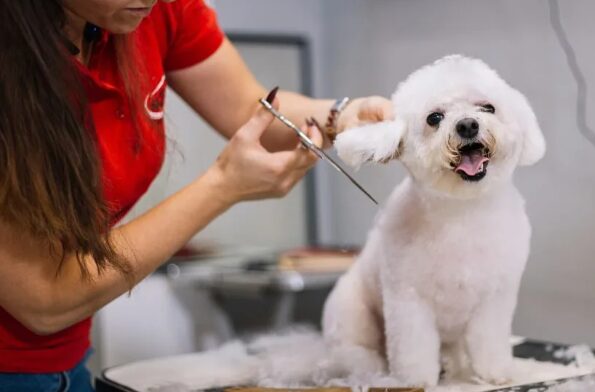Does the thought of grooming your dog at home seem overwhelming? Many dog parents feel intimidated by the grooming process, worried they might hurt their furry friend or do something wrong.
Professional grooming can cost $50-100+ per session, and with dogs needing grooming every 4-8 weeks, the costs add up quickly. Learning to groom your dog at home not only saves money but also strengthens your bond while ensuring your dog’s comfort and health.
Benefits of Home Dog Grooming
Regular grooming prevents matting, reduces shedding, maintains healthy skin, and allows you to check for health issues early. Dogs groomed regularly at home often show less anxiety than those taken to unfamiliar grooming facilities.

Essential Dog Grooming Tools
Basic Equipment
- Quality dog brush (specific to your dog’s coat type)
- Metal comb for detailed work
- Nail clippers (guillotine or scissor type)
- Dog-specific shampoo (pH balanced for canine skin)
- Towels (microfiber works well)
- Hair dryer (dog-specific or human on cool setting)
Advanced Tools
- Grooming scissors for trimming
- Electric clippers with various blade lengths
- Thinning shears for blending
- Ear cleaning solution
- Dental care supplies
Step-by-Step Dog Grooming Process
Preparation Phase
- Exercise your dog first – A tired dog is more cooperative
- Gather all tools before starting
- Choose a secure location with non-slip surfaces
- Stay calm and positive – dogs pick up on your energy
The Grooming Sequence
Step 1: Pre-Grooming Inspection Check for cuts, bumps, parasites, or skin irritation. Address any issues before proceeding.
Step 2: Brushing and Detangling Start with a thorough brushing, working from head to tail. For matted areas, use a detangling spray and work gently with fingers before brushing.
Step 3: Nail Trimming Trim nails before bathing when they’re harder and easier to cut cleanly. Cut only the white tip, avoiding the pink quick.
Step 4: Ear Cleaning Use dog ear cleaner and cotton balls to gently clean visible areas. Never insert anything deep into the ear canal.
Step 5: Bathing
- Use lukewarm water
- Wet thoroughly, avoiding eyes and ears
- Apply shampoo and massage gently
- Rinse completely (leftover soap causes irritation)
- Towel dry first, then blow-dry on cool setting
Step 6: Final Brushing and Trimming Brush the clean, dry coat and trim any areas that need attention. Start conservatively—you can always cut more.
Breed-Specific Grooming Considerations
Short-Haired Breeds (Beagles, Boxers)
- Weekly brushing with rubber curry brush
- Monthly baths or as needed
- Focus on nail care and ear cleaning
Long-Haired Breeds (Golden Retrievers, Setters)
- Daily brushing to prevent mats
- Professional trimming every 6-8 weeks
- Extra attention to feathering on legs and tail
Double-Coated Breeds (Huskies, German Shepherds)
- Never shave (disrupts temperature regulation)
- Daily brushing during shedding seasons
- Use undercoat rake for thorough grooming
Curly/Wavy Coats (Poodles, Doodles)
- Professional grooming every 4-6 weeks
- Daily brushing to prevent matting
- Learn basic face and sanitary trimming
Common Dog Grooming Mistakes
- Rushing the process – Take time to keep your dog comfortable
- Using human products – These can irritate dog skin
- Cutting nails too short – This causes pain and bleeding
- Ignoring the dog’s stress signals – Panting, drooling, or trembling means take a break
- Attempting complex cuts without experience – Start simple and build skills
Creating Positive Grooming Experiences
- Start young if possible, but older dogs can learn too
- Use high-value treats throughout the process
- Keep sessions short initially and gradually increase duration
- End on a positive note even if you don’t complete everything
- Practice handling paws, ears, and mouth when not grooming
When to Seek Professional Help
Consider professional groomers for:
- Complex breed-specific cuts
- Severely matted coats
- Aggressive or extremely anxious dogs
- Tasks you’re uncomfortable performing
Real Success Story
Mark adopted a rescue Golden Retriever with severe matting. Instead of expensive professional dematting, he learned gradual techniques over several weeks. Now he maintains his dog’s coat beautifully at home and has saved over $1,200 in grooming costs annually.
Troubleshooting Common Issues
Dog won’t stay still: Start with shorter sessions, use treats, and ensure they’re adequately exercised first.
Fear of water: Introduce gradually, use shallow water, and make bath time positive with treats and praise.
Nail cutting anxiety: Practice touching paws daily, start with just one nail, and reward generously.
Start Your Dog Grooming Journey
Begin with simple tasks like brushing and gradually build your skills. Your dog will appreciate the one-on-one attention, and you’ll love the bonding experience.